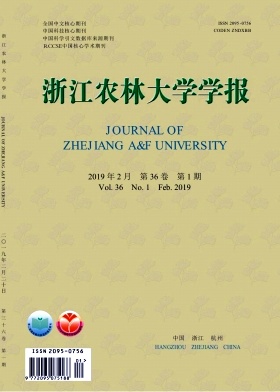-
湖北省地处华中地区,该地区植物具有南北过渡特征,既有大量北方种类的落叶阔叶树,也有多种南方种类的常绿阔叶树,同时又处于中国东西植物区划的过渡地带,便于临近地区植物成分侵入,是中国生物资源较丰富的地区之一[1]。苔藓植物作为植物界中的一个重要类群,种类仅次于种子植物,由于植物体矮小,构造简单,常常不被人们注意,但是它们发挥着重要的生态作用。1888年,首次有外国学者在湖北省采集苔藓植物标本,之后中国学者在该区域陆续开展了相关研究,但研究深度与广度还远远不够。目前,湖北省苔藓植物相关研究较少,主要集中在武汉[2-3]、黄冈[4-5]、黄石[6-8]、神农架[9-11]及宜昌[12]等地区开展了有关苔藓植物种类多样性和区系的研究,针对苔藓植物的分布及多样性与环境因子间的关系的定量研究仅有1篇[13]。通过对这些文献进行归纳和总结,发现湖北省目前共有苔藓植物94科265属800余种。然而,与相近的贵州(94科,366属,1 643种)[14]地区相比,湖北苔藓植物数量远低于贵州地区,这很可能与苔藓植物在湖北的研究广度有一定关系。因此,可推测湖北地区苔藓植物种数比目前研究所得出的结果要更丰富。恩施作为湖北生物多样性最为丰富地区之一,素有鄂西林海之称。其中位于恩施宣恩县的七姊妹山国家级自然保护区以独特的气候条件和复杂的地形特征为苔藓植物的生长提供了非常适宜的居住环境,该区海拔1 650~1 950 m内就分布有974.64 hm2的亚高山泥炭藓沼泽湿地,该地区的泥炭藓发育良好,部分区域泥炭藓的盖度达到了100%,高度近50 cm[15]。虽然前期调查研究涉及了该保护区内泥炭藓种类及其分布规律,但是保护区内苔藓植物区系和物种多样性的调查研究未见相关报道。本研究对该保护区内采集的苔类植物标本进行鉴定,并与其他保护区进行比较,分析该地区苔类植物区系特征,为七姊妹山国家级自然保护区乃至湖北省苔藓植物种类多样性、区系研究,以及苔藓植物资源保护提供基础资料。
HTML
-
湖北七姊妹山国家级自然保护区位于湖北省恩施土家族苗族自治州宣恩县的东部,地处云贵高原东北部和武陵山区交汇地带。地理坐标为29°39′30″~30°05′15″N,109°38′30″~109°47′00″E,保护区主峰海拔为2 014.5 m,总面积34 550 hm2。保护区内河网密布,纵横交错;属于亚热带季风湿润型气候,年均降水量为1 418.9 mm,年均气温为16.3 ℃。该地区植物资源较为丰富,符合亚热带季风湿润型气候区的植物分布特点[16]。
-
2016年8月和2017年7月共2次到该保护区进行苔类植物调查,野外标本采集路线分为2条:一是沿着山间小道于丛林中采集;二是沿着山间溪流寻找和采集。采集土生、石生和树生的苔类植物,采集过程中对标本进行编号,并记录其生长环境、海拔、采集日期等信息,共采集苔类标本210份,目前所有标本存放于湖北民族学院生物多样性标本馆植物标本储藏厅。室内采用解剖镜和显微镜进行形态观察,并结合相关文献,进行标本鉴定,整理名录,同时参照吴征镒的《中国种子植物属的分布区类型》[17],分析比较研究区域苔类植物区系特征。
-
以七姊妹山国家级自然保护区为中心,并在其东(浙江清凉峰30°04′~30°31′N,118°52′~119°12′E)[18],西(重庆大巴山31°37′~32°12′N,108°27′~109°16′E)[19-20],南(广西十大万山21°40′~22°04′N, 107°29′~108°13′E)[21],北(陕西佛坪33°33′~33°46′N,107°40′~107°55′E)[22]各选取1个保护区进行辐射比较,探讨七姊妹山自然保护区苔类植物的过渡地带性特征。为了进一步分析30°N苔类植物从东至西区系特征变化规律,依次选取浙江清凉峰(30°04′~30°31′N,118°52′~119°12′E),江西阳际峰(27°51′~28°02′N,117°11′~117°28′E)[23],湖北神农架(30°15′~31°57′N,109°56′~110°58′E)[9],重庆大巴山(31°37′~32°12′N,108°27′~109°16′E)这4个保护区为比较对象。相似性系数[24]和区系谱[25]计算公式如下:Kroebers相似性系数=c(a+b)/(2ab)。其中:a为地区A的种数、属数、科数,b为地区B的种数、属数、科数,c为地区A和地区B的共有种数、共有属数、共有科数。区系谱FER=(FEi/T)×100%。其中:FEi指某区系中n种区系成分的第i区系成分的分类群数量(属或种),T指某区系中分类群总数,FEi和T均不包括世界分布类型的种类。
1.1. 研究区概况
1.2. 研究方法
1.3. 数据分析
-
七姊妹山保护区苔类植物有26科33属51种(表 1),占湖北省苔类植物总科数的76.47%,总属数的55.93%,总种数的27.56%;占全国苔类植物[26]总科数的43.33%,总属数的21.71%,总种数的4.86%。

Table 1. List of species of the Qizimei Mountain National Nature Reserve in Hubei Province
-
通过对七姊妹山国家级自然保护区苔类植物的调查,同时根据已经发表的所有有关湖北省苔藓植物的相关资料发现:裸蒴苔科Haplomitriaceae为湖北新记录科;假护蒴苔属Metacalypogeia和裸蒴苔属Haplomitrium为湖北新记录属;疣鳞地钱粗鳞亚种Marchantia papillata subsp. grossibarba,粗裂地钱风兜亚种Marchatia paleacea subsp. diptera,钝叶护蒴苔Calypogeia neesian,疏叶假护蒴苔Metacalypogeia alternifolia,长叶羽苔Plagiochila flexuosa,卵叶羽苔Plagiochila ovalifolia,南亚异萼苔Heteroscyphus zollingeri,尖瓣扁萼苔Radula apiculata,钩毛叉苔Metzgeria leptoneura,曲枝大萼苔Cephalozia catenulata,稀枝钱苔Riccia huebeneriana,无纹紫背苔Plagiochasma intermedium,圆叶裸蒴苔Haplomitrium mnioides,广西毛耳苔Jubula kwangsiensis,多形带叶苔Pallavicinia ambigua等15种为湖北新记录种。
-
苔类植物与种子植物一样有其地理分布规律,而且与种子植物的分布区类型密切相关[27]。本研究参照吴征镒[17]关于中国种子植物属的分布区类型的划分观点将七姊妹山国家级自然保护区苔类植物区系划分为10种类型(表 2)。其中,世界广布成分有5种,包括地钱Marchantia polymorpha,扁萼苔Radula complanata,绒苔Trichocolea tomentella,石地钱Reboulia hemisphaerica等,由于该区系分布于世界各地,很难体现七姊妹山自然保护区区系地理特点,因此,在各区系地理成分统计中被扣除计算。旧世界热带分布类型包括四齿异萼苔Heteroscyphus argutus,长叶羽苔Plagiochila flexuosa等3种,占总数的6.52%;热带亚洲至热带大洋洲分布类型有南亚异萼苔Heteroscyphus zollingeri和狭瓣细鳞苔Lejeunea anisophlla 2种,占总数的4.35%;热带亚洲至热带非洲分布类型仅1种,狭尖叉苔Metzgeria conjugata,占总数的2.17%;热带亚洲分布类型包括南亚瓦鳞苔Trocholejeunea sandvicensis,毛边光萼苔Porella perrottetiana,刺叶羽苔Plagiochila sciophila等5种,占总数的10.87%;北温带分布类型包括毛叉苔Apometzgeria pubescens,异叶裂萼苔Chiloscyphus profundus,刺叶护蒴苔Calypogeia arguta,绿片苔Aueura pinguis,蛇苔Conocephalum conicum等17种,占总种数的36.96%;东亚和北美间断分布类型仅1种,双齿护蒴苔Calypogeia tosana,占总数的2.17%;旧世界温带分布类型有2种,包括稀枝钱苔Riccia huebeneriana,钩毛叉苔Metzgeria leptoneura,占总数的4.35%;东亚广分布类型包括无纹紫背苔Plagiochasma intermedium,三裂鞭苔Bazzania tridens,小蛇苔Conocephalum japonicum,小睫毛苔Blepharostoma minus,圆叶裸蒴苔Haplomitrium mnioides等13种,占总数的28.26%;中国特有成分包括尾尖光萼苔Porella handeli和广西毛耳苔Jubula kwangsiensis 2种,占总数的4.35%。
区系成分 占总数比例 七姊妹山 清凉峰 大巴山 佛坪 十大万山 世界广布Cosmopolitan 泛热带Pantropic 0 4.55 1.32 0.93 5.71 旧世界热带Old World Tropics 6.52 11.36 0 1.87 35.71 热带亚洲—热带大洋洲Trop. Asia to Trop. Australasia 4.35 0 1.32 3.74 0 热带亚洲—热带非洲Trop. Asia to Trop. Africa 2.17 0 1.32 0.93 0 热带亚洲Trop. Asia 10.87 0 23.68 10.28 0 北温带North Temperate 36.96 27.27 21.05 20.56 17.15 东亚—北美洲E. Asia & N. Amer. disjunted 2.17 4.55 1.32 4.67 7.14 旧世界温带Old World Temp 4.35 9.09 2.63 3.74 2.86 温带亚洲Temp. Asia 0 0 0 3.74 0 东亚分布E. Asia 28.26 31.82 32.89 37.39 24.29 中国特有种Endemic to China 4.35 11.36 14.47 12.15 7.14 Table 2. Floristic spectrum of liverworts in Qizimei Mountains National Nature Reserve and other natural reserves
-
根据以上数据和资料分析,七姊妹山自然保护区苔类植物较为丰富,区系成分中以北温带成分占据主导地位,占总数的36.96%,东亚成分次之,占28.26%;其次热带分布成分(包括泛热带成分、旧世界热带成分、热带亚洲至热带大洋洲成分、热带亚洲至热带非洲成分、热带亚洲成分)占总数的23.91%,温带分布成分(包括北温带成分、东亚—北美间断成分、旧世界温带成分、温带亚洲成分)占总数的46.48%,虽然两者都占有一定的比例,但是温带分布成分高于热带分布成分。
-
将七姊妹山国家级自然保护区与选取的东、西、南、北共4个方位的保护区进行比较。从物种组成特点上分析,七姊妹山国家级自然保护区与佛坪国家级自然保护区在共有科、属、种水平上均最高,十大万山国家级自然保护区则是与七姊妹山国家级自然保护区共有科、属、种最少的地区;根据属相似性系数分析,七姊妹山国家级自然保护区苔类植物与其他4个保护区的相似性程度均非常高(0.615~0.689),而且各相似性系数数值非常接近;根据种相似性系数分析,七姊妹山国家级自然保护区与清凉峰国家级自然保护区的种相似系数最高,十大万山国家级自然保护区最低(表 3)。从苔藓植物地理成分区系谱上分析,除十大万山国家级自然保护区以旧世界热带和东亚分布为主外,各地区苔类植物区系分布类型均以北温带和东亚分布为主,佛坪国家级自然保护区的苔类植物分布类型最广,有13种分布类型;此外,各地区热带成分以十大万山国家级自然保护区(41.42%)最多,大巴山国家级自然保护区(27.64%)和七姊妹山国家级自然保护区(23.91%)次之,佛坪国家级自然保护区(17.75%)和清凉峰国家级自然保护区(15.91%)最低;而温带成分七姊妹山国家级自然保护区(46.48%)最高,清凉峰国家级自然保护区(40.91%)和佛坪国家级自然保护区(32.71%)次之,十大万山国家级自然保护区(27.15%)和大巴山国家级自然保护区(25%)最低(表 3)。
保护区 科数/科 属数/属 种数/种 共有科数/科 共有属数/属 属相似性指数 共有种数/种 种相似性指数 七姊妹山 26 33 51 清凉峰 20 29 49 17 19 0.615 17 0.34 大巴山 21 31 82 19 22 0.688 21 0.33 佛坪 25 34 111 21 23 0.686 23 0.32 十大万山 18 31 71 13 15 0.689 14 0.23 Table 3. Comparison of liverwort composition similarity between Qizimei Mountain National Nature Reserve and other natural reserves
通过将七姊妹山国家级自然保护区与30°N上从东向西选取的4个保护区对比分析发现(图 1),阳际峰国家级自然保护区在物种数量上均具有最高的水平,神农架国家级自然保护区最低;七姊妹山国家级自然保护区苔类物种数量与清凉峰相近。从东向西30°N上物种数量呈先升高后降低又增高的趋势。另外各保护区区系类型数量上,阳际峰国家级自然保护区的苔类植物区系类型最为复杂,可达13种,神农架国家级自然保护区的分布类型最少,仅有6种。区系类型和苔类物种数正相关,物种数越多,相应的区系类型数也越多。30°N上,从东向西区系类型数量呈现一个“N”的变化趋势。
2.1. 科、属、种的组成
2.2. 湖北新纪录科、属、种
2.3. 区系成分特征
2.3.1. 区系成分构成
2.3.2. 区系成分特点
2.3.3. 与其他保护区比较
-
根据吴鹏程等[28]对中国苔藓植物分区划分,七姊妹山国家级自然保护区属于华中区,该区植被为常绿落叶阔叶混交林,具有中亚热带山地的典型植被类型,研究发现该区苔类植物物种丰富,以北温带为主,东亚成分次之。由此可得出七姊妹山国家级自然保护区具有明显的温带性质,温带分布成分高于热带分布,是热带、亚热带分布成分向北扩展和北温带分布类型向南延伸的地带,具有从亚热带向温带过渡的特征。七姊妹山国家级自然保护区泥炭藓沼泽种子植物区系和邻近的星斗山自然保护区苔藓植物区系也印证了这一特征,这也与该保护区所处的地理位置和种子植物区系[16]特点相吻合。同时,东亚成分次之,表明了该保护区具有浓厚的东亚色彩。其次,中国—日本成分比中国—喜马拉雅成分较高,这可能由于中与日本相邻的日本诸岛直到第三纪上新世仍与东亚大陆相连,两者的植物区系易于交流[29]。
通过与其他4个保护区进行比较,发现七姊妹山国家级自然保护区与清凉峰国家级自然保护区物种相似程度最高,与十大万山国家级自然保护区物种相似程度最低,这可能是由于七姊妹山与清凉峰国家级自然保护区二者纬度最接近,主峰海拔相差不大,且都受亚热带季风性气候所影响有关。十大万山国家级自然保护区位于中国南部沿海,属于北热带季风气候区,其地理位置和气候特征与七姊妹山国家级自然保护区相差大,因而种相似程度最低,相应的区系类型也不一样。除十大万山国家级自然保护区(热带成分为主)外,各分布类型均以北温带和东亚分布为主。同样,30°N上,与清凉峰等保护区的对比发现,七姊妹山国家级自然保护区与其他保护区物种相似性指标接近,各区系类型均以北温带和东亚分布为主。虽然,有研究发现同一纬度带上针叶树占阔叶树的比例从西向东有逐渐增大的趋势[30],而本研究发现,30°N上苔藓从东至西区系物种数量呈现先升高后降低又增高的变化,且各保护区海拔高度、气温和降水等影响苔藓植物多样性的环境因子均比较接近。这种变化差异可能与各保护区局部地形有关,因为苔藓植物个体更加矮小,微生境的变化均可导致物种组成和多样性的差异[31]。
-
感谢重庆师范大学刘艳教授和上海师范大学于晶教授提供的大巴山和清凉峰的苔类植物名录,以及韩国营老师在鉴定方面给予的帮助。








 DownLoad:
DownLoad: